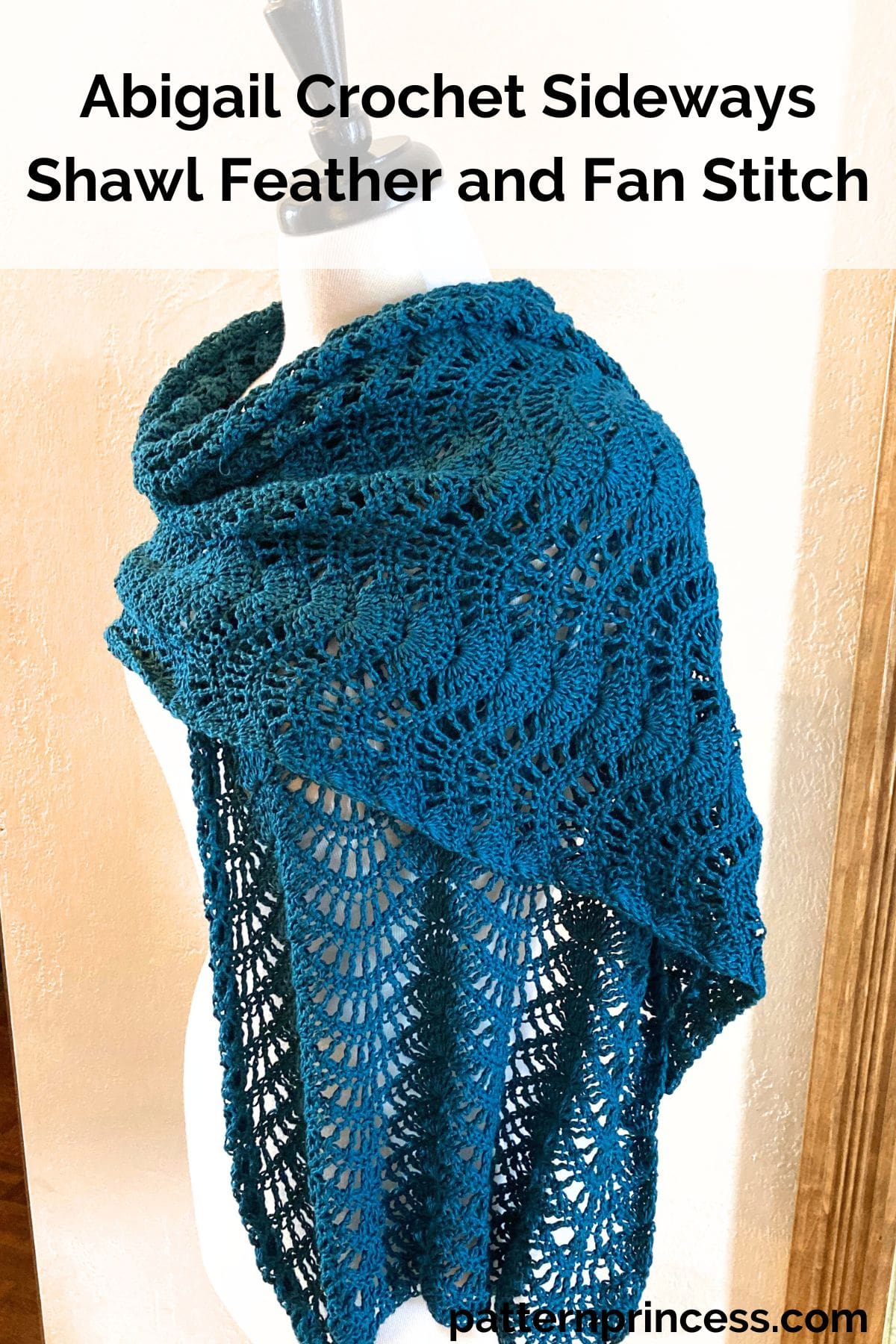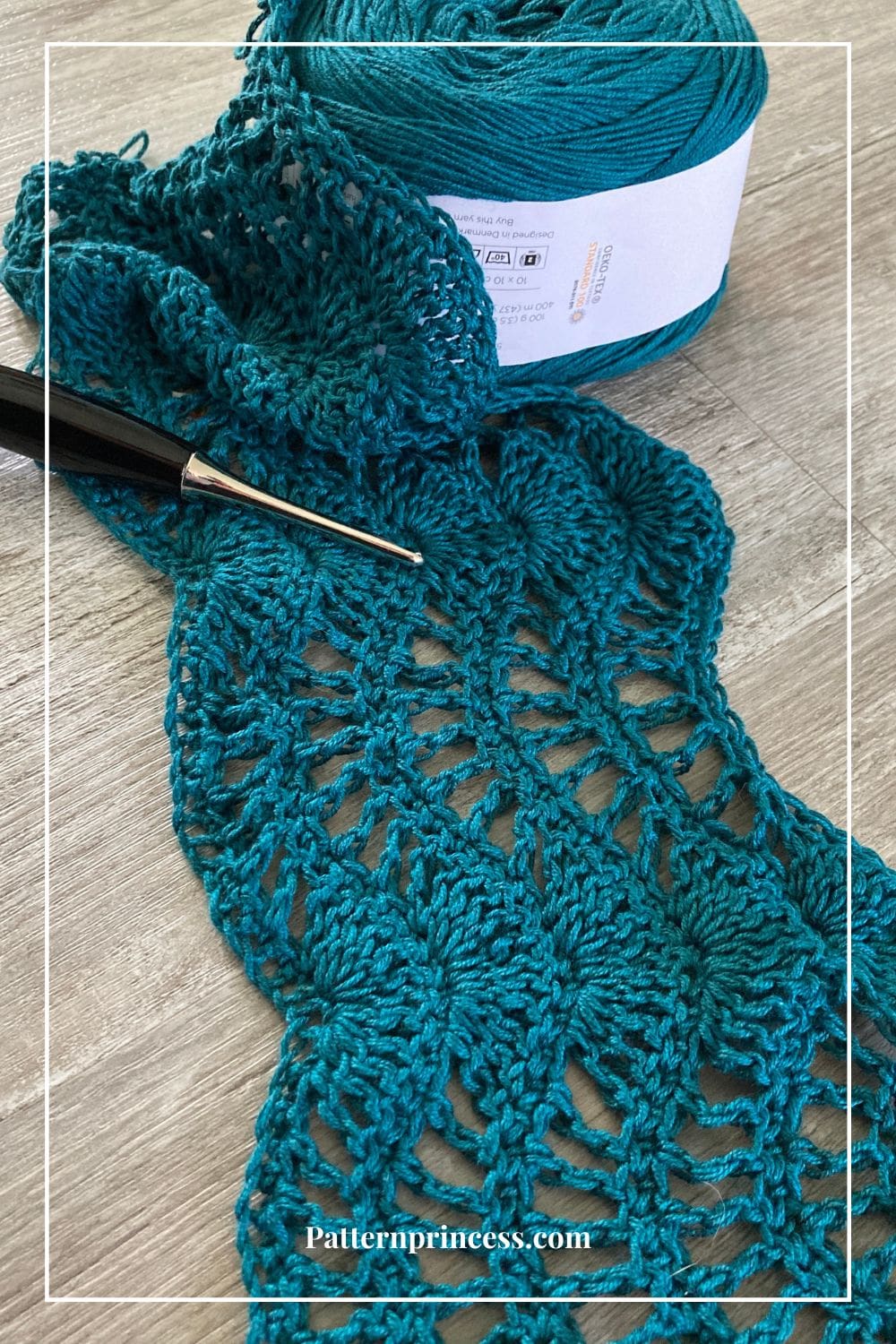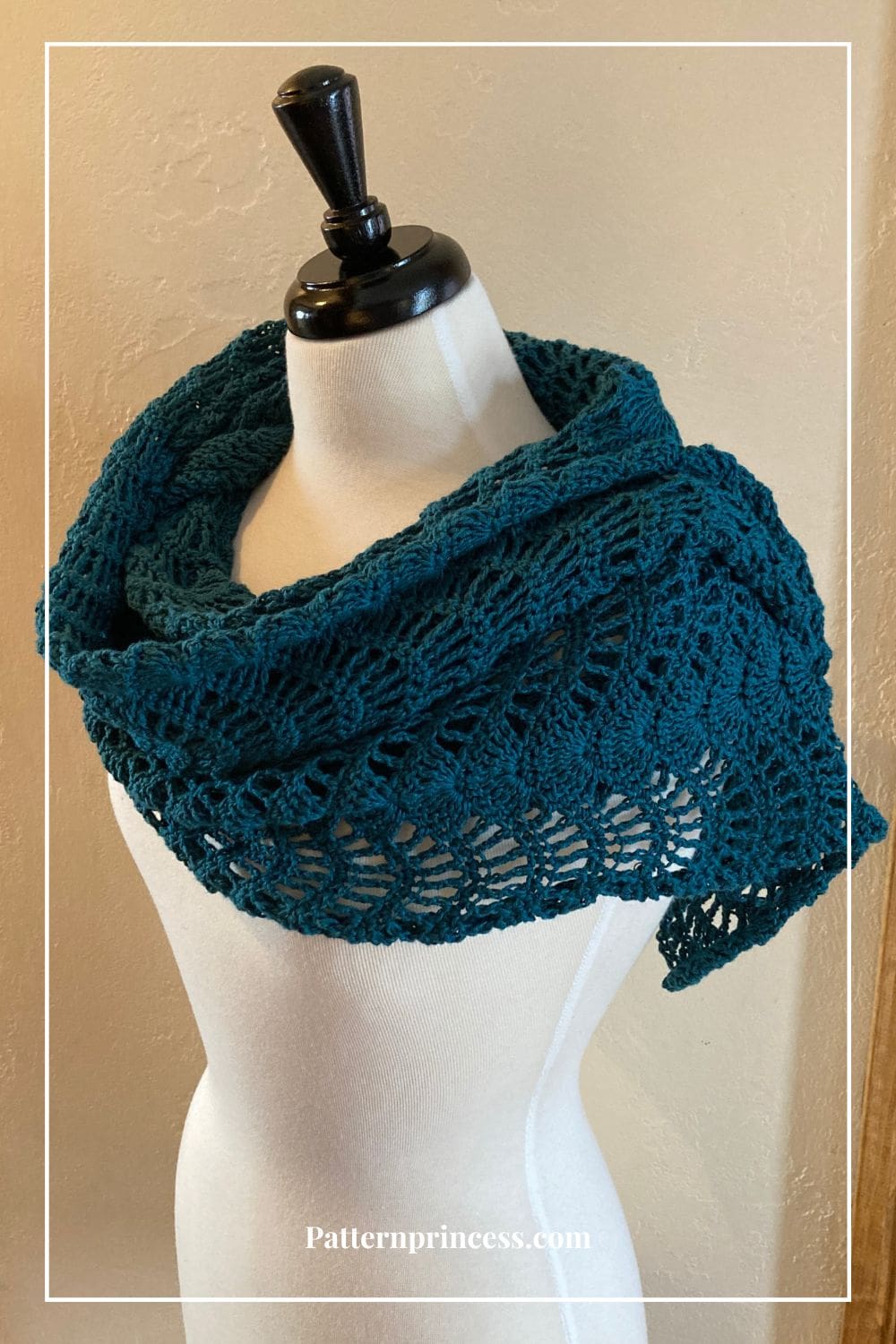Last updated on October 4th, 2025 at 02:52 pm
This Abigail Crochet Sideways Shawl uses the Feather and Fan stitch pattern, which forms a gorgeous drape thanks to its lace structure. It is sure to become a cherished keepsake for years to come.
Add a pop of vibrant style to your fashion. If you’re into the challenge of working with laceweight yarn, this pattern is perfect for you.
Craft a timeless piece that combines elegance with the joy of creating something truly special. Create clusters of stitches and strategically skip others. When these techniques come together, they produce a gorgeous wave effect throughout your shawl, adding a touch of beauty to your handcrafted creation.

Post contains affiliate links, and we earn commissions if you shop through the links on this page. For more information, please read the disclosure section under the About Us page.
2024 Gift to Myself Crochet Along
This pattern is part of the 2024 Gift to Myself Crochet Along. Starting from the 2nd of January and running all the way until February 1, 2024, Underground Crafter is teaming up with 14 crochet designers to bring you a new and permanently free crochet pattern on Tuesdays, Wednesdays, and Thursdays. Each pattern will fit the theme of something you would crochet for yourself.
Each pattern is specifically designed just for this free crochet pattern roundup.
All the patterns in this CAL are forever free on the blog of each designer and specially designed for this event.
Sometimes, we have different free patterns available for download. Head on over to our free PDF printables page. It is a good idea to sign up for the newsletter, so you are notified when the free downloads are uploaded.
Written Pattern, Photo Tutorial, and Video Tutorial for the Crochet Stitches
The Feather and Fan crochet stitch pattern creates a mesmerizing ripple effect, making it perfect for creating shawls, blankets, scarves, and more. I still have a baby blanket using this stitch on my bucket list of crochet projects.
This elegant crochet stitch is easy once you get a few rows in as it is a stitch repeat of rows 2 and 3. Any time a pattern repeats like this, I find it becomes easier to do with each row.
We have a whole blog post written on how to crochet the feather and fan stitch. It includes a written pattern, photo tutorial, and a video tutorial to walk you through each step.
If you want to see this pattern worked in the fingering weight yarn, head on over to the YouTube channel for a quick video on crocheting this gorgeous wrap.
Crochet Feather and Fan Wavy Stitch
The Feather and Fan stitch is a well-known Shetland pattern. It’s sometimes called “Old Shell” or “Old Shale” because the stitch resembles the ocean waves rolling onto sand shales.

Yarn for Sideways Shawl
This beautiful Lacy Crochet Shawl is a free pattern that uses a solid color. However, a variegated yarn would work well with the stunning openwork in this scarf pattern. The breathable and airy feel works well with a wide variety of yarn choices.
Experiment with a different color to create a unique and stunning project that showcases the beauty of this classic crochet stitch.
What type of yarn?
The yarn used for this pattern is a cotton and acrylic blend. It’s a number 2 fine yarn, making it accessible for everyone who enjoys the intricacies of laceweight projects.
This stitch pattern really comes to life after it’s been washed and blocked; the “feather” element opens up beautifully. Natural fibers with good stitch memory work best with this pattern. So wool & cotton blends are a good example. Synthetic yarns such as acrylic may not give the desired result.
This wrap is the first project I blocked. However, due to the 45% acrylic blend in this yarn, it doesn’t hold the blocking shape as well as I would like to see. If you are interested in blocking your project, I have more detail on how to block a crochet project below the written pattern.

Versatile Sideways Scarf Pattern
This is a great pattern you can style in so many ways. Wear it over the shoulder as a wrap. Tie it in the front and let it hang down as a lacy scarf. Drape over one shoulder for an elegant style. This is a lovely shawl to wear with jeans on a casual day, yet just as gorgeous to wear for an evening out in the town.
Directions: Abigail Crochet Sideways Shawl Feather and Fan Stitch
Skill Level
Advanced Beginner or Intermediate.
You should be able to work the treble crochet stitch and single crochet stitch.
Gauge
18 stitches and 4 rows every 4 inches using the treble crochet.
Size
The size of this shawl is 20 inches wide X 62 inches long.
Change the width by adding or increasing the beginning chain stitches. The pattern repeat for this project is a multiple of 19 plus 20. That means that a minimum chain needs to be at least 39 stitches.
Change the length by adding or decreasing the rows.
Materials Needed
Twister solid in color 107 from Hobbii. Two yarn cakes with 437 yards each or 874 yards total.
You can find a link to the Hobbii yarn store on our Savings Page.
Crochet Hook Size H, 5.0 MM
Yarn needle
Scissors
Abbreviations
CH = Chain
SC = Single Crochet
SK = Skip
ST = Stitch
STs = Stitches
TR = Treble Crochet
[ ] = Repeat Between

Special Stitches Used
Treble Crochet Stitch
A treble crochet, also referred to as the triple crochet stitch is taller than a double crochet.
To make the Treble Crochet Stitch. Yarn over twice, insert the hook through both loops and pull up a loop. Next, yarn over and pull through two loops on the hook. Yarn over again and pull through the next two loops. Lastly, yarn over again and pull through the last two loops on the hook.
You can find more free crochet tutorials and special crochet stitches.
Pattern Notes
Turn at the end of each row.
The chain four at the beginning of row 2 and every other row after counts as a treble crochet.
Chain 1 for the single crochet rows does not count as a stitch.
Keep your stitches loose. Make sure to place your last stitch in the top stitch of the previous row turning chain. This helps make the sides very straight.
This pattern is written in U S Crochet Terms.
When working row 2, you are working treble crochet stitches making the soft peaks and valleys. Row 3 is simply single crochet stitches across.
Since you will be skipping stitches in row 2, it is nice to have the single crochet worked in each stitch in the first row. This helps the beginning look just like the last row.

Feather and Fan Shawl Instructions
Start with a Foundation Chain of 77.
Row 1
SC in the second CH from the hook and in each ST across. Turn (76 STs)
Row 2
CH 4 (Counts as a Treble Crochet here and throughout pattern). Work 4 TR in the Same ST (or 5th ST from the hook). [TR in the next ST. (SK SC, TR in the next ST). Repeat between ( ) 8 times. Work 5 TR in the next SC and another 5 TR in the next SC]. Repeat between [ ] to the last 18 SC. Work TR in the next ST. [SK SC, TR in the next ST]. Repeat between [ ] 8 times. Work 5 TR in the last SC. Turn
Row 3
CH 1 (Does not count as a ST). SC in the first ST and in each ST across. Turn
Rows 4 through 123
Continue repeating rows 2 and 3 until your project reaches the desired length.
You’ll notice that as you repeat these rows, the feather and fan pattern will start to take shape.
Finishing
When you’ve reached your desired length, finish your work. Cut the yarn leaving about a 12-inch yarn tail. Pull the yarn through the last loop on the hook. Weave in any loose yarn ends with the yarn needle. Snip off any excess yarn.
Block your feather and fan shawl as desired

Why Would You Block a Crochet Project?
Blocking is a crucial step in the finishing process for many crochet projects. It involves shaping and setting the final dimensions of the item, and it offers several benefits:
Evening Out Stitches. Blocking helps even out stitches, especially in lace or openwork patterns. It can stretch and define stitches, giving your project a more polished and professional appearance.
Setting the Shape. For items like garments, shawls, or accessories, blocking helps set the shape and dimensions. This is particularly important for achieving the intended drape, fit, or overall look of the project.
Removing Wrinkles and Creases. Blocking can eliminate wrinkles, creases, or fold lines that may have formed during the crocheting process or while the project was stored.
Adjusting Size. If your project turns out slightly smaller or larger than anticipated, blocking can help adjust its size to meet your intended measurements.
Aligning Motifs or Patterns. For projects with specific stitch patterns, motifs, or color changes, blocking helps align these elements, ensuring they look uniform and well-defined.
Removing Sizing or Stiffness. Commercially produced yarn or certain crochet threads might have sizing or stiffness. Blocking can help remove these characteristics, providing a softer and more comfortable finished product.
Fixing Tension Issues. Blocking can correct tension issues, especially if your tension varied throughout the project. It helps create a more consistent fabric.
Showcasing Lace Patterns. For lace projects, blocking is essential to open up the lace and showcase the intricate details. It allows the beauty of lacework to shine.
Not all projects require blocking, and the decision to block depends on the type of project, yarn used, and personal preference. However, for items where the appearance, drape, and overall finish are crucial, blocking is a valuable technique that can elevate the quality and aesthetics of your crochet creations.
Blocking a Crochet Project
Blocking is a process used to shape and set the final dimensions of your crochet project. It’s especially important for items like scarves where the finished appearance and drape matter. Here’s a step-by-step guide on how to block a crochet scarf for beginners:
Materials Needed:
- Crochet scarf
- Rustproof Pins
- Blocking mats or a clean, dry towel
- Spray bottle with water (optional)
- Measuring tape (optional)
Steps:
Prepare Your Scarf. Make sure that your scarf is clean. Blocking is often more effective on clean, dampened projects.
Choose a Blocking Surface. Lay out your blocking mats or a clean, dry towel on a flat surface. This provides a surface for your scarf to be pinned into shape.
Pin Your Scarf. Lay your scarf on the blocking surface. Use rustproof T-pins to pin the edges of the scarf to the desired dimensions. Make sure to smooth out any wrinkles or uneven areas.
Shape the Scarf. Gently manipulate the scarf into the desired shape. If your scarf has specific stitch patterns or motifs, take the time to shape them neatly. Pay attention to the edges and corners, ensuring they are straight and even.
Spritz with Water (Optional). If your yarn allows, lightly spray the scarf with water using a spray bottle. This is particularly helpful for natural fibers like wool or cotton, as it can help the fibers relax and set in the desired shape.
Allow to Dry. Leave the scarf in place until it is completely dry. This might take a day or more depending on the yarn and the humidity of your environment.
Check Dimensions. Once dry, unpin your scarf and check its dimensions. If needed, you can make small adjustments at this point.
Finish and Wear. Your scarf is now blocked and ready to be worn. Enjoy your beautifully shaped and finished crochet project.
It’s a simple yet effective technique that can make a significant difference in the final presentation of your work.
Free Shawl Crochet Patterns
If you loved this Abigail Crochet Sideways Shawl, we have a few other lacy shawls for you to explore.
- 10 Best Sources for Lacy Crochet Shawl Patterns
- Victoria Lacy Shawl Crochet Pattern
- Lacy Lindsey Crochet Shawl Pattern
- Blushing Beauty Shawl Crochet Pattern
- Stunning Easy Shawl Crochet Pattern
- Crochet Open Weave Summer Shawl

You can find Victoria crocheting, quilting, and creating recipes. She has cooked in restaurants for over 20 years, including many larger parties. She learned to crochet when she was just 11 years old and has been crocheting ever since; over 50 years now. Over 40 years ago, she loved her first class in sewing and continues to hone her skills in quilting. Many have enjoyed the handmade gifts over the years. In her professional career, she has worked in management in a wide variety of businesses including higher education as a dean of a division. All the while attending college part-time to achieve her doctorate in higher education with an emphasis in e-learning.
